We use cookies
Using our site means you agree to the use of cookies and similar technologies. Read about our policy and how to disable them here
Following the revival of interest in fencing that began in France in the 1870s and swept across Europe, bronze and spelter sculptures became popular as trophies and retirement presents for fencing masters. More than 70 sculptors contributed figures in the 60-year period 1880-1940. Here are some that have appeared on the market.
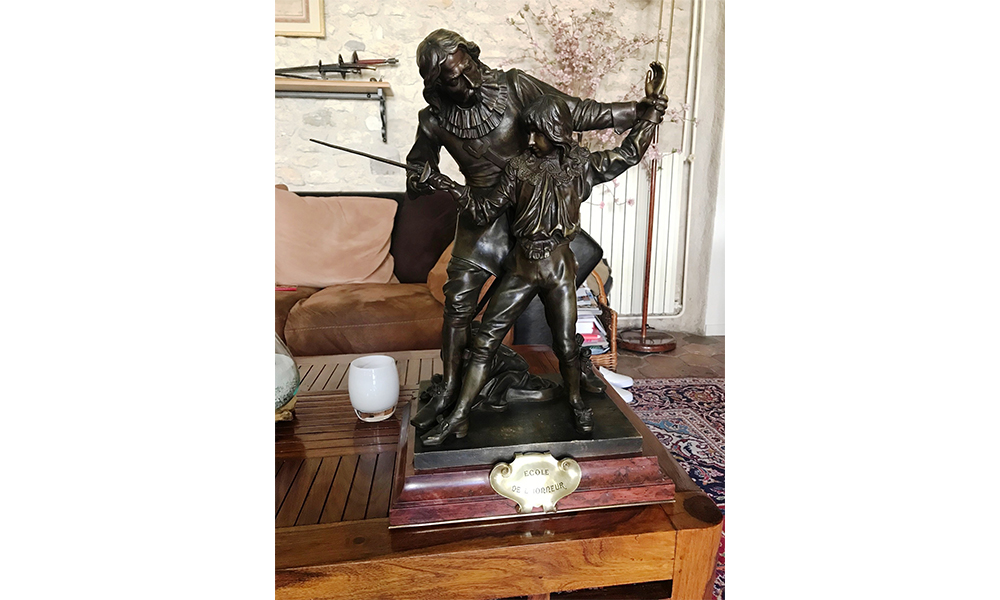
[Fig. 1] c. 1880, La Lecon d’Escrime: Bronze 17th c. style figures of a father teaching his son to fence, signed Gaudez, 58 cm high. [Adrien Etienne Gaudez (1845-1902) was a French sculptor who studied at the Ecole des Beaux-Arts in Paris and exhibited at the Salon from 1864, winning a first class medal in 1881. During the Franco-Prussian War of 1870, he was a prisoner of war. Sold at auction in 2015 for £5000.]
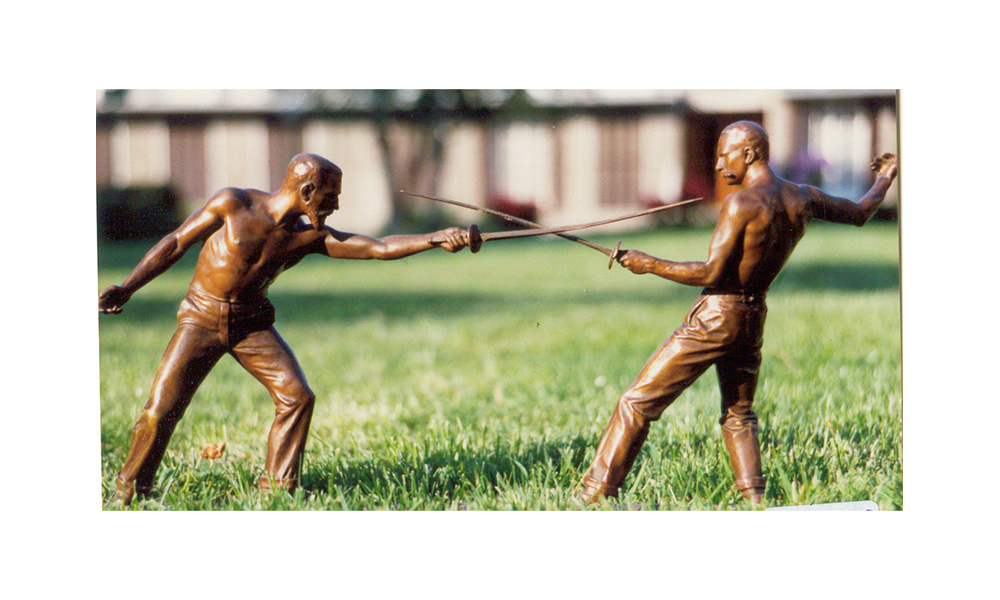
[Fig. 2] 1887, Un Duel: Pair of bronze duellists signed N. Mayer 1887, 58 cm high x 114 cm wide. [Nicolas Mayer (1852-1929) was a French sculptor. The work was exhibited in plaster at the Salon des Artistes Français in 1887, for which he received an honourable mention. Sold at auction in 2015 for £3400. A smaller casting 25 cm high x 50 cm wide was offered by a US dealer in 2020 for £2500.]
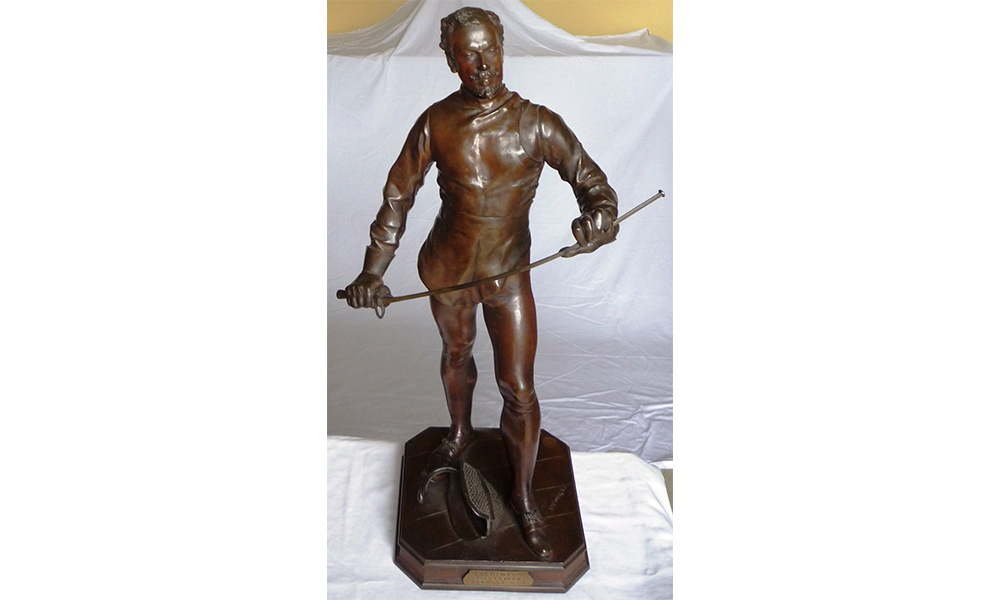
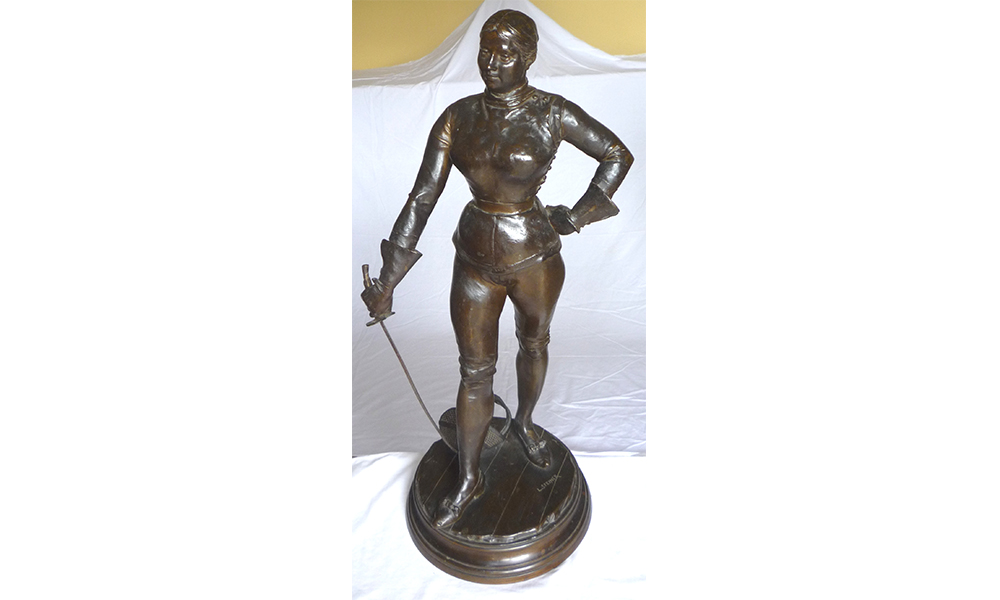
[Figs. 3 & 4] 1889: Two bronze statuettes signed L Steiner. One shows a bearded fencer flexing a foil with a mask at his feet, 62 cm high on a 5 cm high x 23 cm square base to which is attached a plate inscribed Escrimeur par Steiner Medaille D’Or. A 20 mm diameter disc imbedded in the base is stamped 1889 Exposition Universale. The sandal of the leading foot has the traditional sole extending beyond the toes and was used to make a resonant sound during the salute. The female fencer holds a foil in her right hand with a mask at her feet, 58 cm high on a 6 cm high x 25 cm diameter circular base. Casting foundry: Thiébaut Freres. [Clement Leopold Steiner (1853-1899) was a French sculptor who specialised in genre figures. He won a gold medal at the Exposition Universelle of 1889 and sculpted much of the decoration for the Alexandre III bridge. Thiébaut Freres were three brothers whose casting foundry in Paris produced numerous bronze figures in the last two decades of the 19th century. The male fencer sold at auction in 2017 for £7000.]
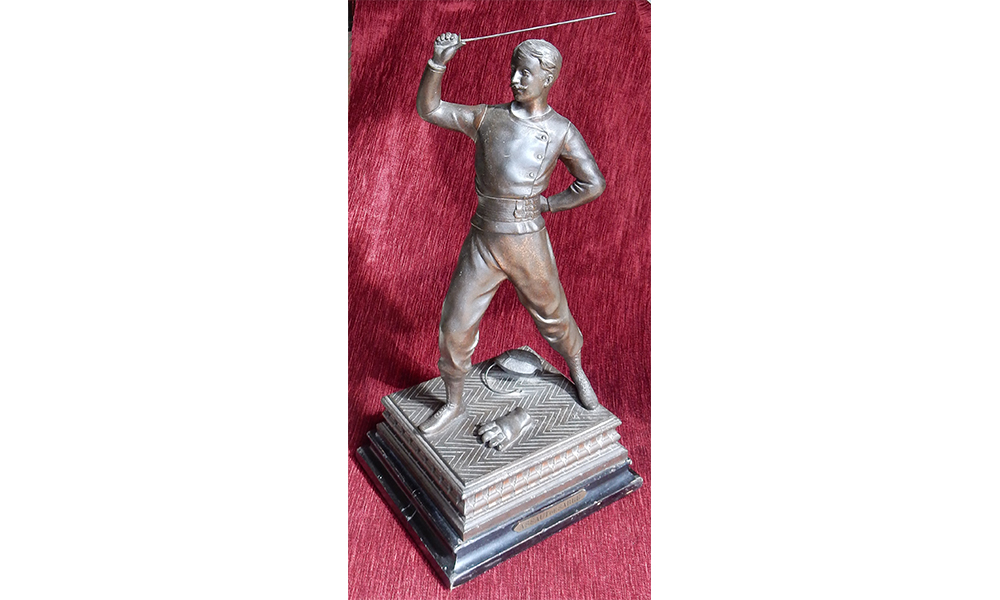
[Fig. 5] c. 1890, Assaut de Sabre: Spelter statuette signed J Belin of a fencer holding a weapon above his head, with a mask and glove at his feet. The figure is 45 cm high on a 6 cm high metal plinth in turn mounted on a 4 cm high wooden base. [Joseph Francois Belin was a French sculptor who died in 1902. Sold at auction in 2014 for £300.]
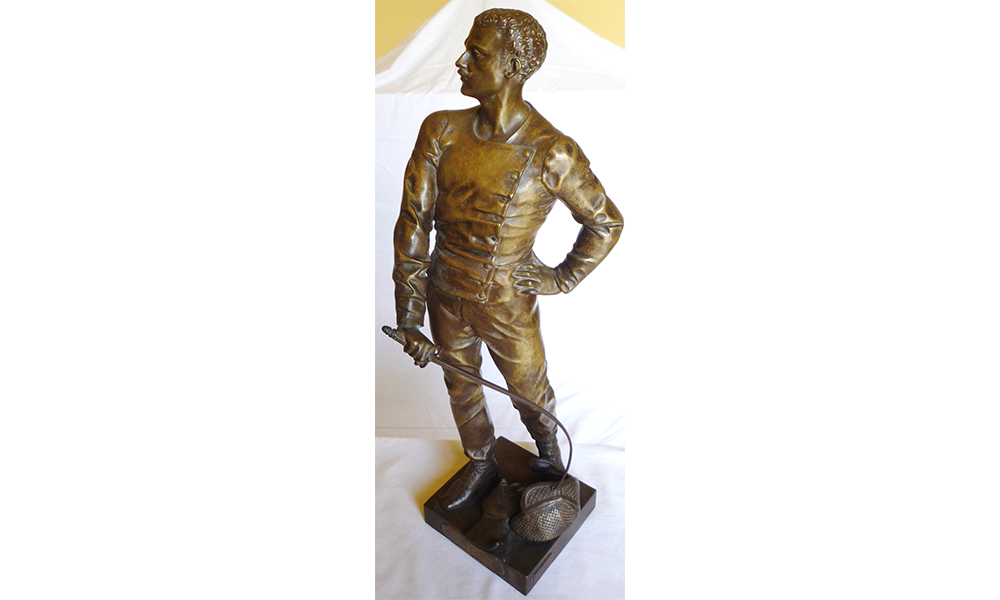
[Fig. 6] 1893: Bronze statuette signed L Madrassi of a fencer flexing his foil against a mask at his feet with a glove next to it, 43 cm high on a 11.5 cm square x 2.5 cm high base. [Luca Madrassi (1848-1919) was born in Italy and studied in Rome and Paris. He exhibited at the Salon des Artists 1881-1896, specialising in busts and statuettes. Sold at auction in 2014 for £1500.]
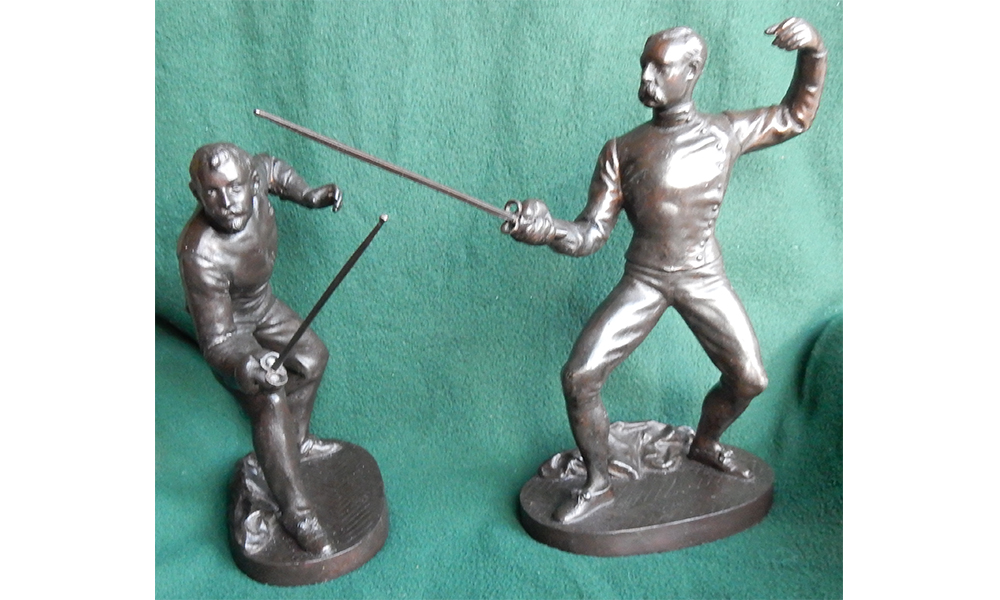
[Fig. 7] Late 19th c., Le bon et le mauvais escrimeur: Pair of spelter statuettes signed Rougelet showing a classical and a rough fencer, 28 cm and 24 cm high respectively on oval bases. [Bénédict Rougelet (1834-94) was a French sculptor born in Tournus where his life-sized statue of the painter Jean-Baptiste Greuze is displayed outside the town hall. Exhibited at the Salon from 1876, getting honourable mentions in 1887 and at the Exposition Universelle of 1889. Sold at auction in 2016 for £1200.]
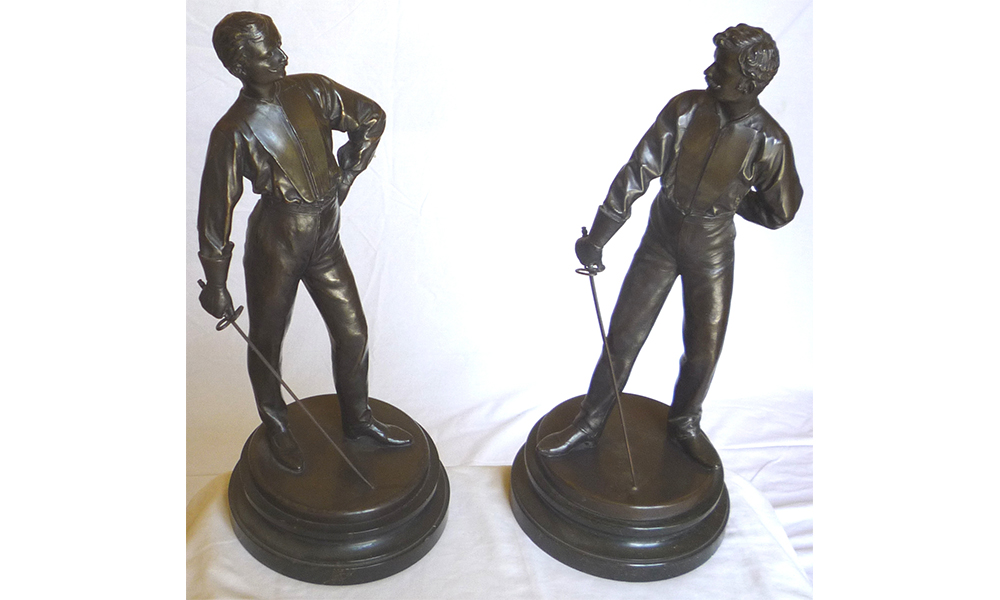
[Fig. 8] Late 19th c: Pair of spelter foilists wearing collarless dress shirts, each holding a foil in their right hand, the points resting on the ground; one figure holds his left hand on his hip, the other grasps a loop on his trousers behind his back, unsigned. Figures are 40 cm high on 5 cm high x 19 cm diameter black marble bases. [Sold at auction in 2000 for £550.]
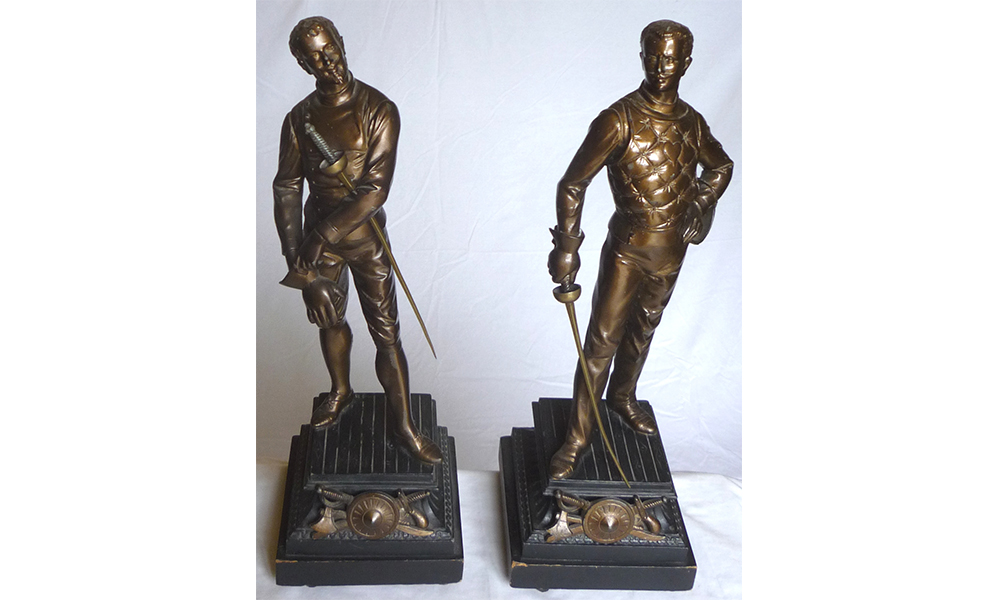
[Fig. 9] Late 19th c: Pair of bronze-painted spelter epeeists after L Raphaël, 35 cm high on 15 cm square x 10 cm high plinths. One wears a fencing jacket and breeches and pulls on a glove, with his epee under his left arm; the other is a fencing master with quilted plastron and long trousers, holding an epee in his right hand with his mask hooked over his left arm. [Sold at auction in 2009 for £680.]
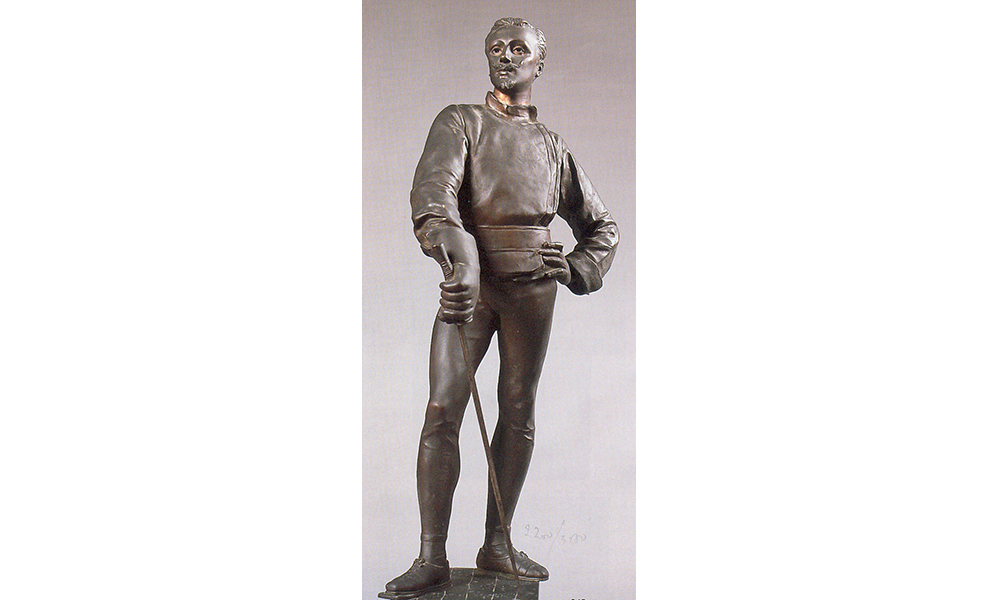
[Fig. 10] Late 19th c: Bronze foilist signed E Laporte, 52 cm high. [Emile Laporte (1858-1907) was a French sculptor, who exhibited at the Salon des Artistes Francais from 1883, winning a second class medal in 1897 and a silver medal at the Exposition Universelle of 1900. Sold at auction in 2013 for £1000.]
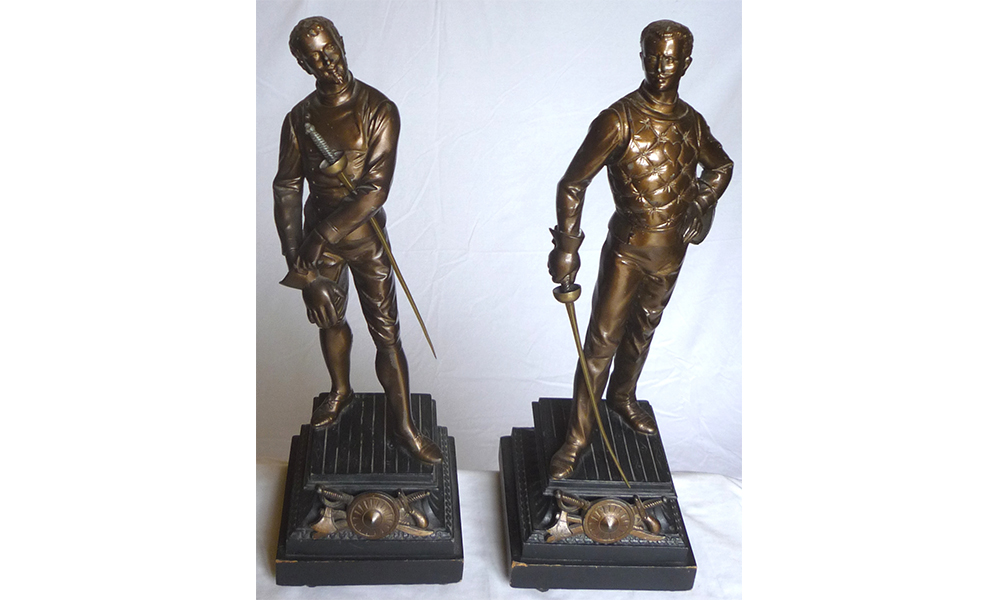
[Fig. 11] Early 20th c. Affaire d’honneur: Pair of bronze duellists signed C. Massé, 29 cm high on 4 cm high x 12 cm diameter bases. One figure faces left flexes his epee, the other faces right and holds his epee across his body. [Charles René Massé (1855-1913) was a French sculptor who worked first in Paris, then in Brienne-le-Chateau where he founded a studio for terra cotta and sandstone work in 1901, and finally in Troyes. These statuettes were first illustrated in Souzy et de Lacam’s 1908 catalogue.]
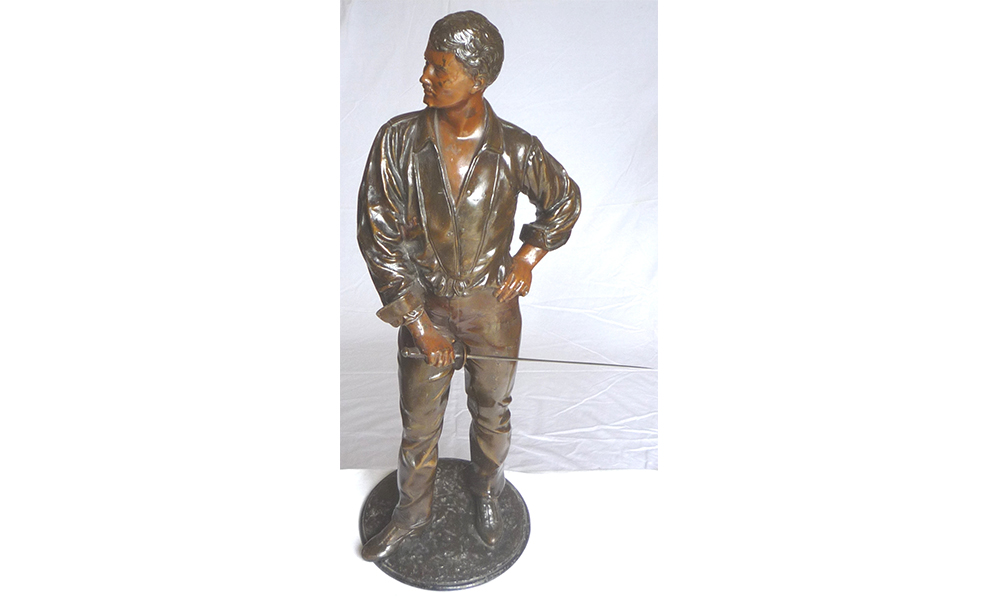
[Fig. 12] Early 20th c: Cold-painted spelter duellist signed Ch Massé, 56 cm high x 18 cm diameter, holding a duelling epee across his body, left hand on hip. [Charles René Massé (1855-1913) was a French sculptor who worked first in Paris, then in Brienne-le-Chateau where he founded a studio for terra cotta and sandstone work in 1901, and finally in Troyes. Sold at auction in 2014 for £420]
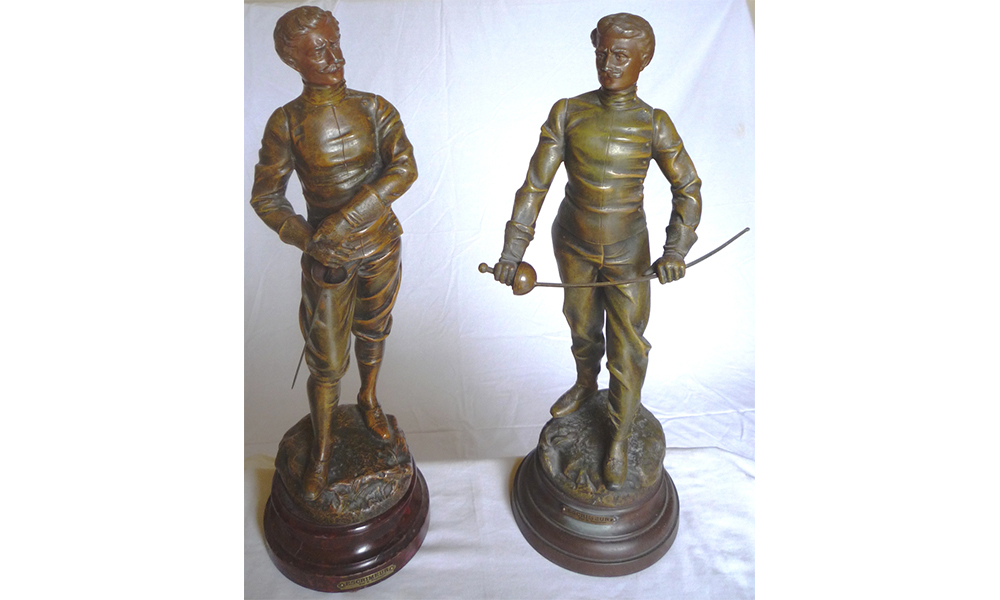
[Fig. 13] Early 20th c: Pair of cold-painted spelter epeeists with patinated brass plaques, each engraved: ESCRIMEUR par X Raphanel. One figure stands with gloved hands resting on the handle of his epee, 38 cm high on a 6.5 cm high x 14 cm diameter turned wooden simulated marble base; the other flexes his epee across his body, 38 cm high on a 6 cm high x 15 cm diameter spelter base. [The French sculptor Xavier Raphanel (1876-1957) graduated from the Ecole des Beaux-Arts in Paris. Sold at auction in 2011 for £900.]
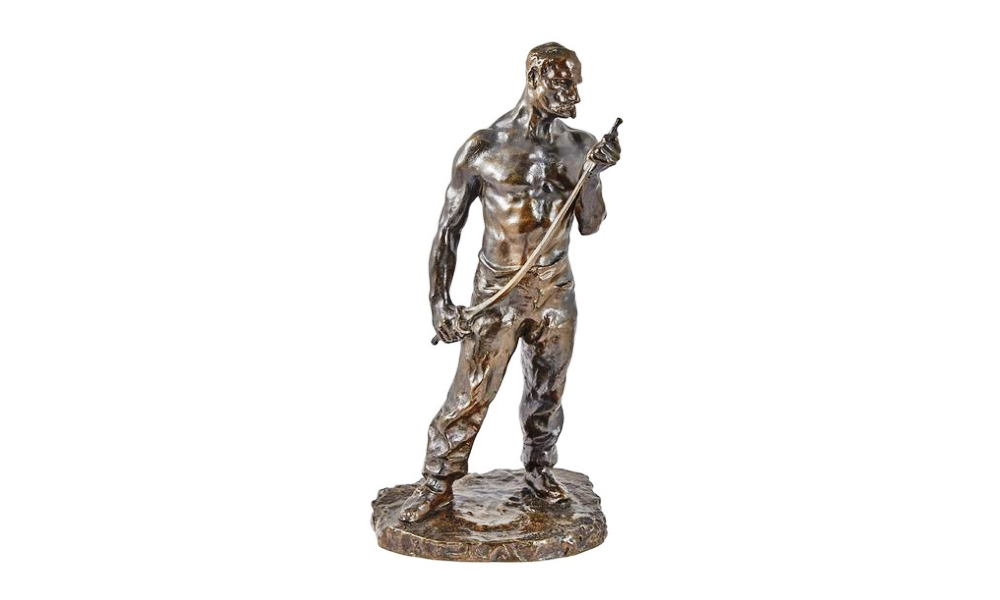
[Fig. 14] Early 20th c: Bronze fencer stripped to the waist examining the tip of his foil, signed Bernhard Hoetger, 41 cm high. [Bernhard Hoetger (1874-1949) was an Expressionist German sculptor influenced by Auguste Rodin. Although a member of the Nazi Party, in 1936 Hitler declared his art to be degenerate and he was expelled from the party. Unsold at a French auction in 2020 at £5000.]
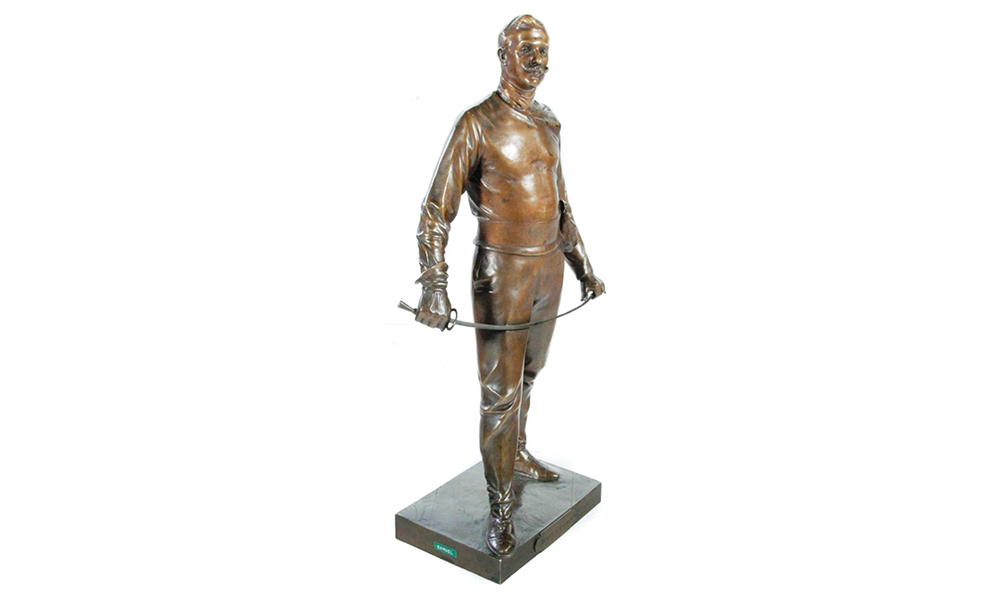
[Fig. 15] Early 20th c., Avant L’Assaut: Bronze fencer signed Ch. Samuel, flexing a foil with glove under left arm, 61 cm high. [Charles Samuel (1862-1939) was a Belgian sculptor, engraver and medallist. Sold at auction in 2020 for £1000.]
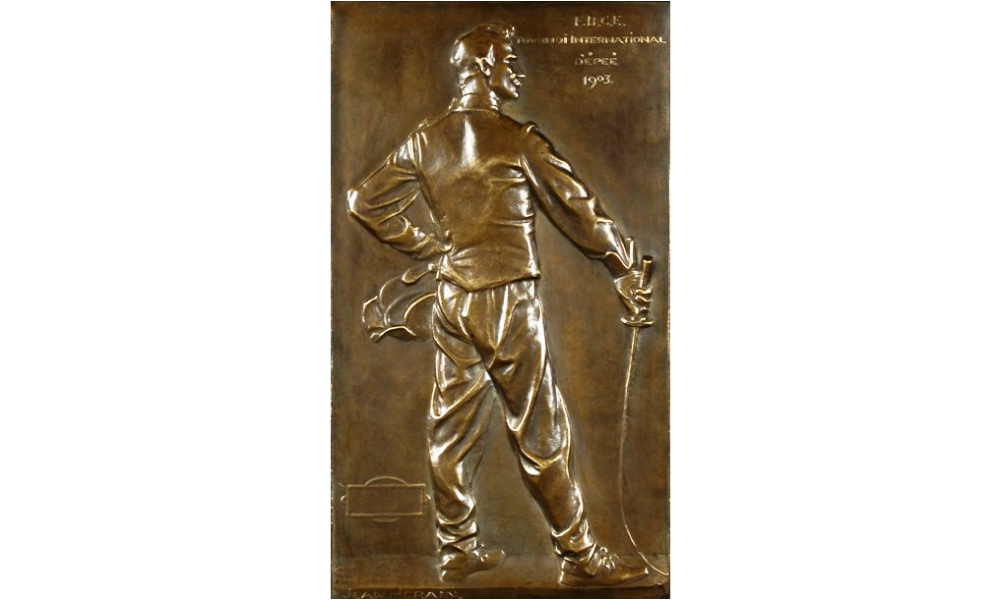
[Fig. 16] 1903, Tournoi International d'épée de 1903: Bronze plaquette signed Jean Hérain, 44 cm high x 25 cm. [Jean Marie Hérain (1853-1924) was a Belgian sculptor who specialised in genre figures. Sold by a French dealer in 2010 for £1100.]
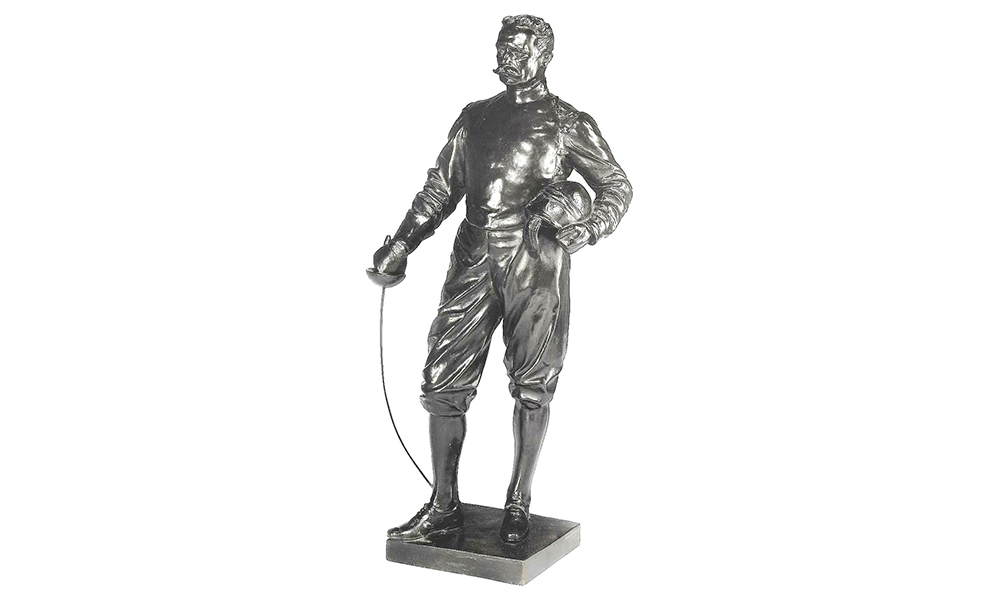
[Fig. 17] 1908: Bronze statuette of Lord Desborough signed V C Bonanni, 70 cm high, dated 1908. [Professor V C Bonanni is included in Mapping the Practice and Profession of Sculpture in Britain and Ireland 1851-1951, an online database relating to sculptural practice between the Great Exhibition of 1851 and the Festival of Britain in 1951. Sold at auction in 2019 for £1500.]
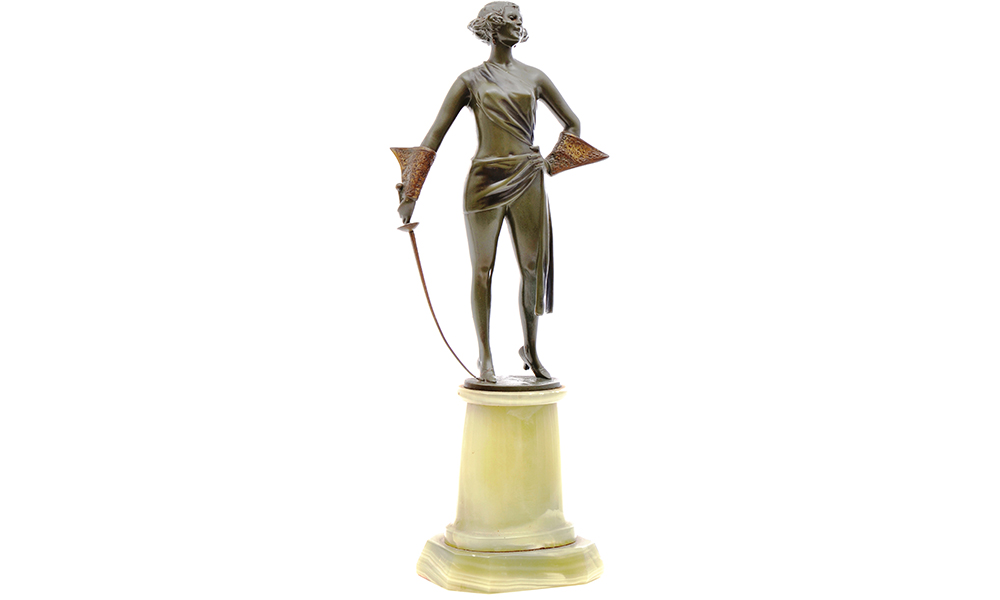
[Fig. 18] 1920s: Bronze figure of a scantily clad woman on a marble plinth holding an epee, signed Bruno Zach, 24 cm high. [Bruno Zach (`1891-1935) was an Austrian sculptor specialising in erotic Art Deco figures. Sold at auction in 2015 for £1500.]
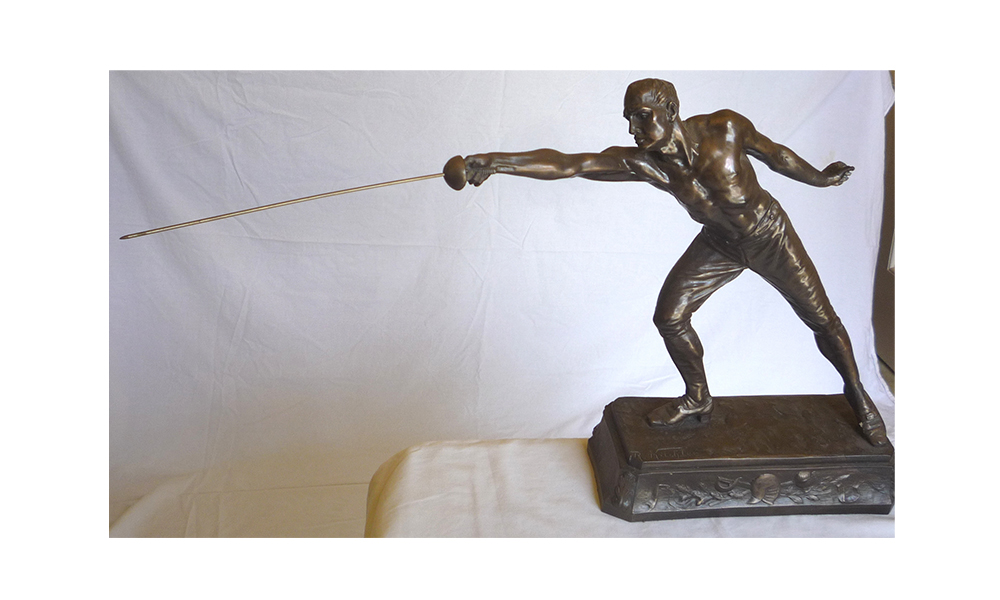
[Fig. 19] 1920s: Cold-cast resin bronze duellist signed R. Küchler, 60 cm long x 38 mm high x 12 cm deep, showing a man stripped to the waist, half lunging with a duelling epee, mounted on an integral base decorated with crossed sabres and helmet. [Rudolf Küchler (1867-1954) studied at the Vienna Academy of Fine Arts and then worked in Berlin creating architectural sculpture and commemorative medals during World War I; he also produced portrait busts and statuettes. Sold at auction in 2011 for £2500.]
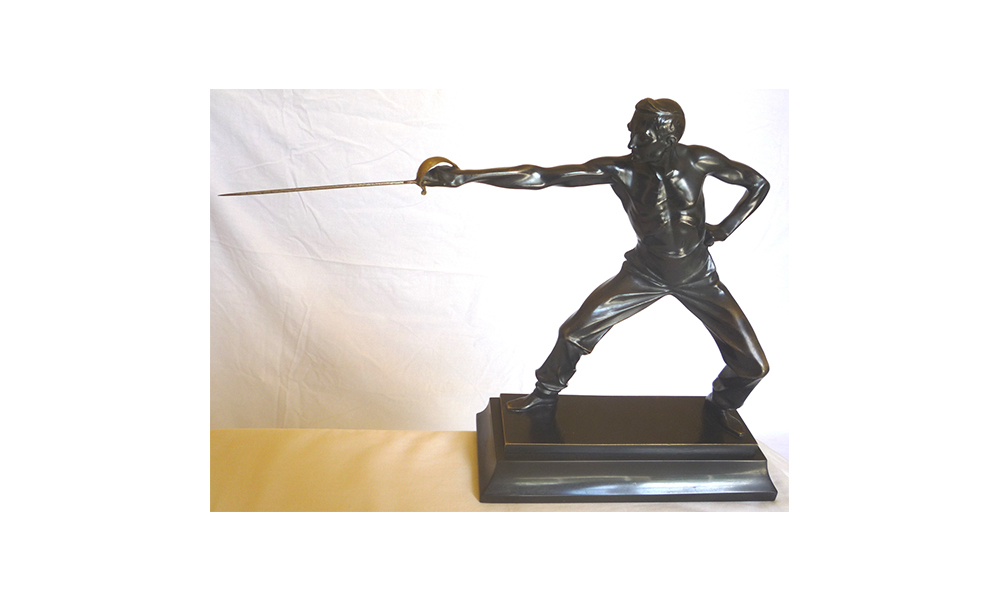
[Fig. 20] 1920s: Bronze statuette of a duellist signed Th. Ullmann, 36 cm long x 28 cm high x 9 cm deep, showing a man stripped to the waist holding a duelling sabre; casting foundry: AR. [Theodor Ullmann was an Austrian sculptor active from 1915 to the 1930s. The bronze was cast at the Arthur Rubenstein foundry in Vienna. Sold on ebay in 2015 for £635.]
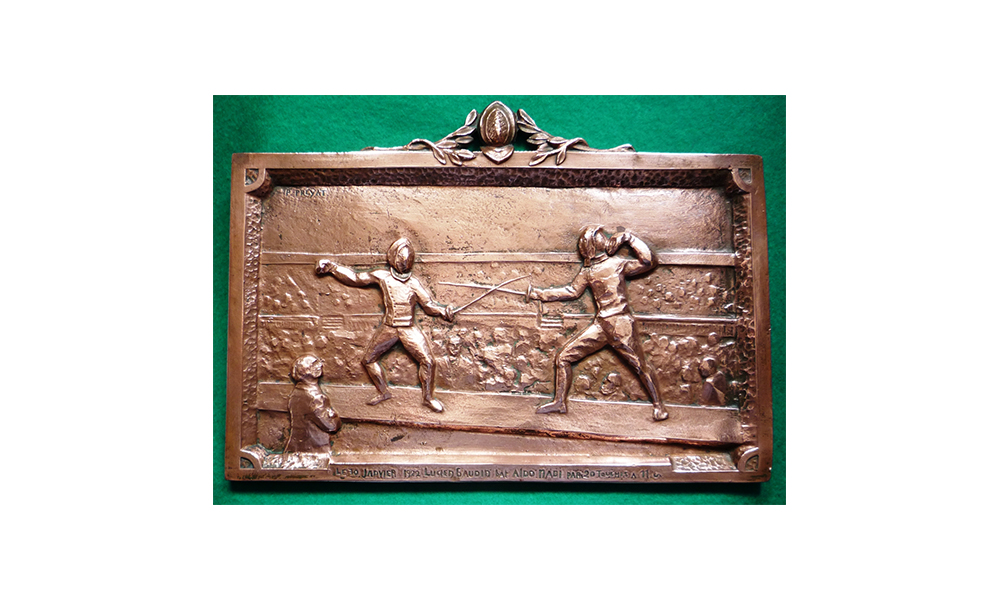
[Fig. 21] 1922: Bronze plaque signed P Preyat, 25 x 18 cm, inscribed Le 30 Janvier 1922 Lucien Gaudin bat Aldo Nadi par 20 touches a 11. [Paul Preyat (1892-1968) entered the Ecole des Beaux Arts, Paris, in 1912. Wounded in 1915 causing his right arm to be amputated, he went on to become president of the federation of those crippled in the Great War. Exhibited at the Salon des Artistes Français in 1921. Received a gold medal at the Exposition des Beaux Arts in 1928. Sold by a French dealer in 2013 for £350.]
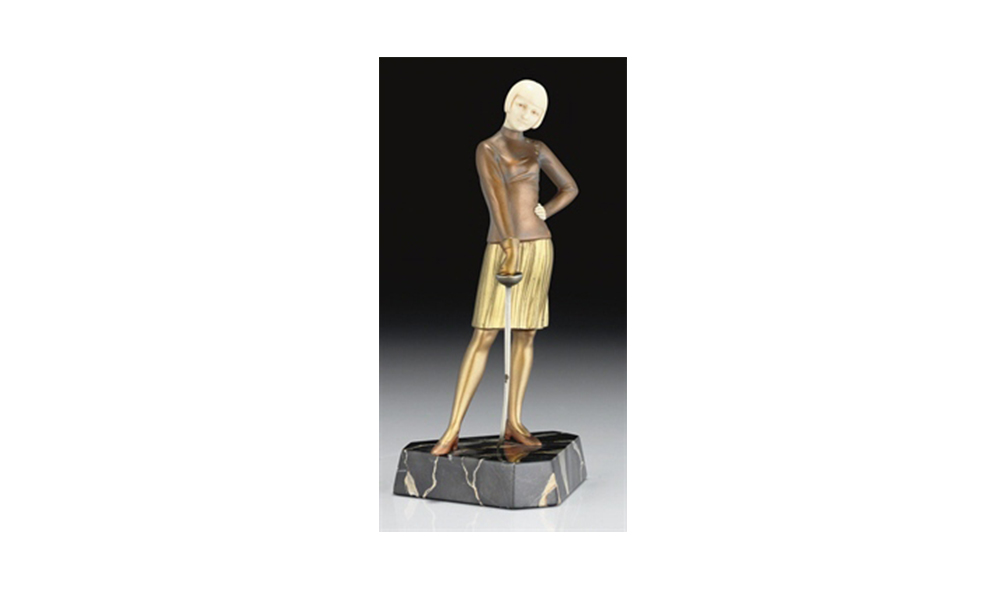
[Fig. 22] c. 1925: Cold-painted bronze and ivory statuette signed F Preiss, 18 cm high, showing a woman flexing an epee on the ground, left hand on hip, on a triangular marble base. [The German sculptor Ferdinand (Fritz) Preiss (1883-1943) studied in Berlin and Paris where he worked between the wars. His painted bronze and ivory statuettes of long-limbed sportswomen and dancers were initially derided as kitsch, but became fashionable and he is now regarded as one of the greatest sculptors of the Art Deco period. Sold at auction in 2018 for £5200.]
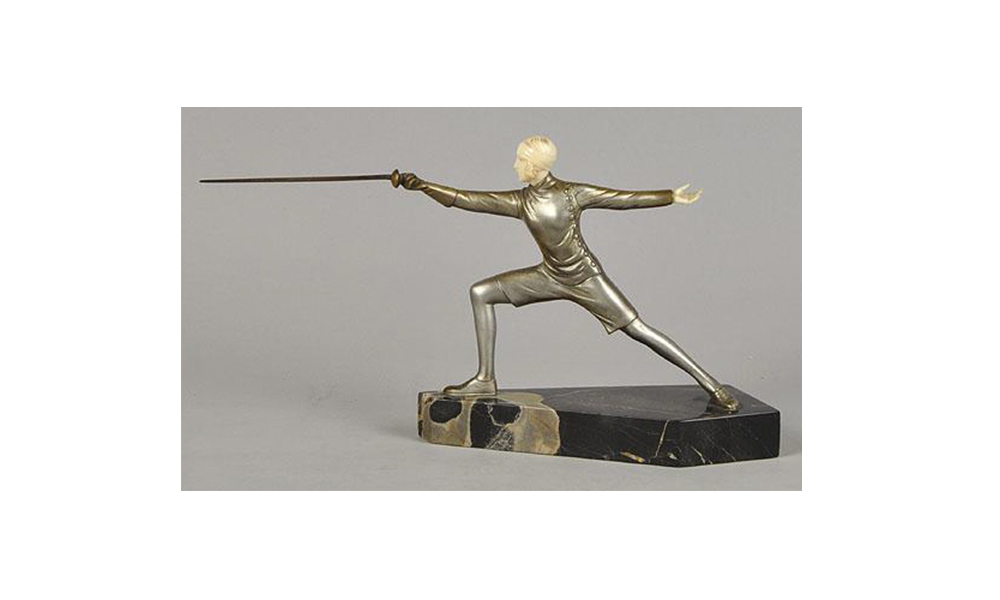
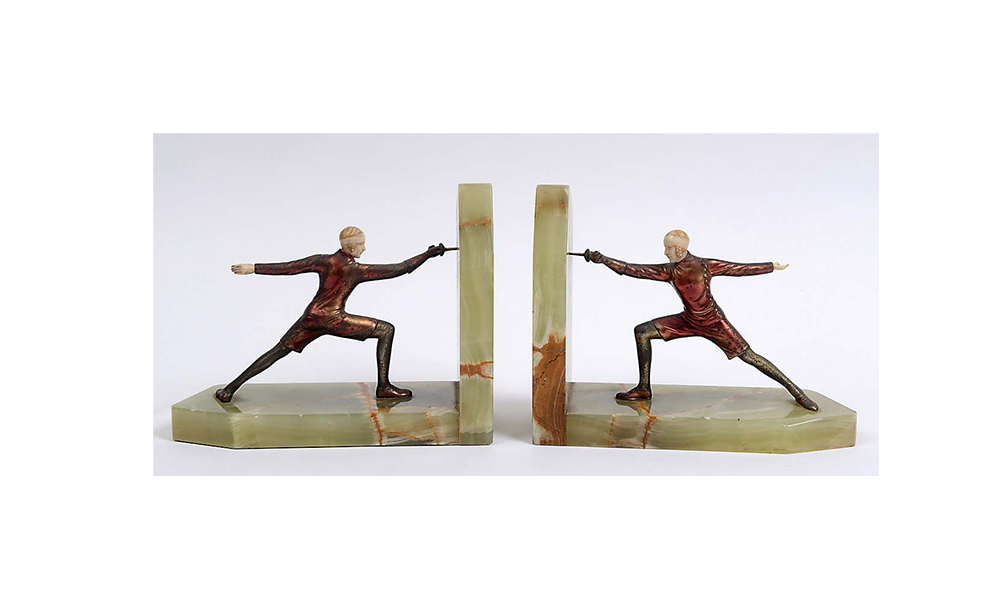
[Figs. 23 & 24] 1928: Bronze and ivory statuettes signed R W Lange of Helen Mayer, 1928 Olympic champion, single figure 13.5 cm high, bookends 16.5 cm high. [Richard W Lange (1879-1944) was a German sculptor who worked in the Classical and Art Deco styles and is known for bronze and ivory figures. Single figure sold by a British dealer in 2009 for £3850; bookends (chips to both hands and a crack on one head) sold at auction in 2018 for £1350.]

